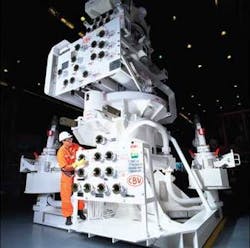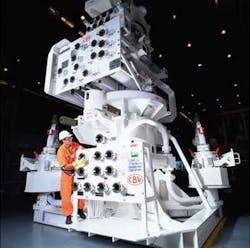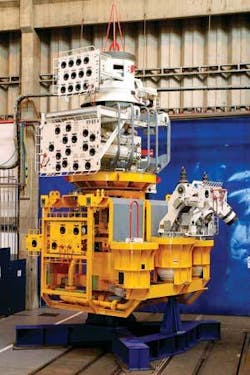SUBSEA/SURFACE SYSTEMS
Ted Moon • Houston
Petrobras signs frame agreements for subsea trees
Petrobras recently signed two nearly identical frame agreements with two different supply companies for subsea christmas trees. The first, with Aker Kvaerner’s Subsea Brazil affiliate, is a two-year agreement valued at approximately $84 million with an option to extend the contract by one year.
Under the agreement, Aker will provide 30 subsea christmas trees with associated tools. The first set will consist of 9 dual-bore trees designed to a 2,000-m water depth plus associated sets of tools. Delivery is set for the next 12 months out of Aker Kvaerner’s facility in Curitiba, Brazil. “This award confirms not only Aker Kvaerner’s performance and close cooperation with Petrobras on previous similar projects, but also Aker Kvaerner’s established position as a strong supplier of christmas trees in Brazil,” says Raymond Carlsen, executive vice president, Aker Kvaerner Subsea in Brazil.
The second frame agreement, signed with FMC Technologies, also is a multi-year frame agreement for 30 subsea trees and related equipment. FMC Technologies estimates the total revenue for these trees, also designed for 2,000-m water depth, will approximate $80 million over a three-year period if all the subsea trees contemplated under the agreement are ordered.
Petrobras has placed the initial order with FMC for five trees, which will be engineered and manufactured at FMC’s facility in Rio De Janeiro, Brazil.
“FMC has enjoyed a long and productive relationship with Petrobras,” says Peter Kinnear, president, FMC Technologies. “We are pleased to support them as they continue with deepwater developments offshore Brazil.”
Both Aker and FMC have long working relationships with Petrobras and the Brazilian offshore market. Through its FMC CBV Subsea business, FMC Technologies has supplied subsea solutions for the Brazilian oil industry since 1961. Aker Kvaerner has delivered more than 130 subsea christmas trees to Petrobras since the start of operations in Brazil.
These are merely the latest in a series of subsea equipment contract agreements by Petrobras. In May of this year, Petrobras signed a contract with Vetco Gray Brazil for the supply of 10 subsea tree systems to be installed offshore Brazil. The trees will be built for 2,000-m water depth and 20-year field life. The tree systems will be full-clad in the production bore, and three individual Vertical Connection Modules; for production, gas lift and the electric-hydraulic umbilical are included in the scope. Vetco Gray, also no stranger to Brazil, has provided subsea wellheads and subsea tree systems in Brazil for more than 30 years, with more than 1,000 subsea wellheads and 180 subsea trees produced and installed there.
Norson uses remote flooding to complete deepwater project
Aberdeen-based Norson Services recently completed a deepwater pipeline operation offshore Angola using its subsea remote pipeline flooding and pigging system. The engineering company was awarded a multi-million dollar contract which involved all subsea-based flooding and pigging operations on the Lobito Tomboco field offshore Angola.
Norson Services developed the subsea Remote Flooding Module (RFM) to flood and pig pipelines in deepwater. Using the RFM and Subsea Hydrotest Pump (SHP) on behalf of Subsea 7 and Chevron, Norson’s Pipeline, Process and Umbilical (PPU) division flooded and pigged 15 subsea pipelines ranging from 3 in. to 12 in. in diameter and 4 km to 9 km in length in water depths of over 550 m, with filtered, treated water.
Les Graves, director of the PPU division, explained how the process works: “Newly installed pipelines are laid on the seabed at atmospheric pressure. Our remote flooding module uses the available seawater pressure outside the pipe as a source of power and water to flood and pig the lines while still meeting the desired filtration and chemical protection specifications. The benefit of our remote system is that it is ROV friendly and removes the need for connection to a surface vessel, thus saving substantial costs and time.”
DMT Orders 5 Triton XLS ROVs
Perry Slingsby Systems will supply 5 Triton XLS Work Class Remotely Operated Vehicles (ROVs) to Deep Marine Technology Inc. Delivery of these ROVs will begin in April 2007 at a rate of one vehicle per month. The 150-hp, 3,000-m depth rated Triton XLS ROVs will be furnished with 600 m of useable tether and enhanced capabilities including:
- 15-in. thrusters
- Station keeping capabilities
- Survey suite
- Ethernet capabilities.
“These ROVs will help fulfill the increasing demands of the offshore oil and gas industry here in the Gulf of Mexico and international markets,” says DMT’s CEO, Paul McKim. “At DMT, we have noticed a developing trend of higher utilization of ROVs and felt now was the time to act in order to stay ahead and anticipate customer needs.”


